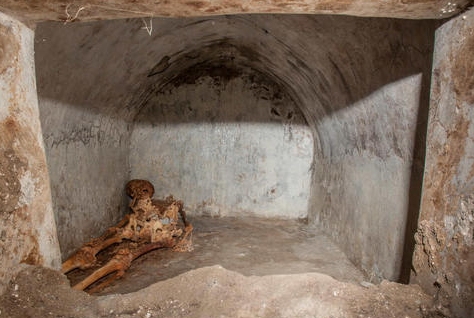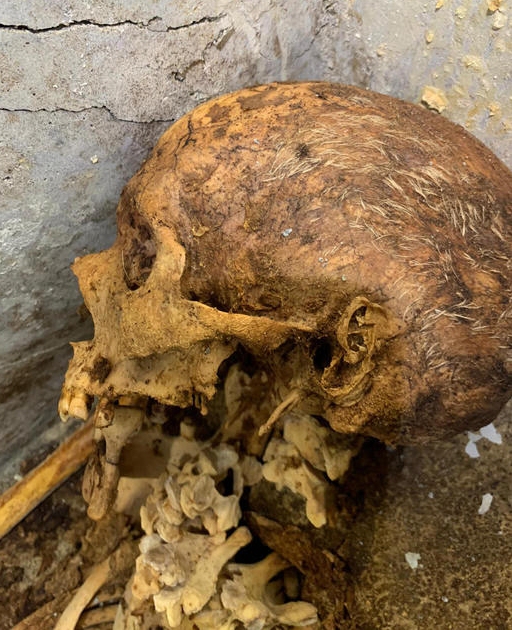|
|
|
|
|||
|
Roman Roman Enemies Other Organizations
|
The semi-mummified body of a pompeian found (Italy)August 16th, 2021
Pompeii (Italy). A very special tomb, a fence, with a façade decorated with green plants on a blue background and a room for inhumation in a period when in the city the bodies of adults were always incinerated. And also a marble inscription from which comes the first confirmation that in the theaters of the Roman colony, at least in the last decades before the eruption of 79.C, it was also recited in Greek. It is once again a fascinating story full of mystery that comes from the last extraordinary discovery of the Archaeological Park of Pompeii, brought to light thanks to a campaign of excavations conducted together with the European University of Valencia. 
The tomb and the body of Marcus Venerius Secundio A discovery on which an interdisciplinary team of experts is working and from which a lot is expected - underline unanimously the director of the Park Gabriel Zuchtriegel and Llorenç Alapont of the University of Valencia - also for the conservation conditions of the deceased, who appears partly mummified, the head covered with white hair, an ear partially preserved, as well as small portions of the fabric that wrapped it. "One of the best preserved skeletons of the ancient city," Zuchtriegel tells ANSA. In fact, in short, a gold mine of scientific data. "Pompeii never ceases to amaze and confirms a story of redemption, an international model, a place where we have returned to do research and new excavations", applauds the Minister of Culture Dario Franceschini, thanking "the many professionalism of cultural heritage that with their work do not stop giving the world extraordinary results that are a source of pride for Italy". 
Detail of the skull with preserved hair Built immediately outside Porta Sarno, one of the important access gates to the city, the tomb, which dates back to the last decades of Pompeii's life, belongs to Marcus Venerius Secundio, a freedman who in life had been before the guardian of the Temple of Venus, a very important temple because the Romans had named the city after Venus, as well as the ministry of the Augustals and finally, certainly only after tampering, also Augustale, or member of a college of priests of the imperial cult. A former slave, therefore, who after the ransom had reached a certain economic ease, enough to be able to afford a level tomb in an absolutely prestigious place. And so much so that he can boast, precisely in the inscription of his tomb, of having given "Greek and Latin games for the duration of four days", which could assimilate him to the highest and most cultured social class of the town, because in that period, explains Zuchtriegel, in the Mediterranean area "the Greek language was a bit like english for us today", very widespread, therefore, but not within everyone's reach in Pompeii where, however, the wealthiest families went crazy for Homer, Aeschylus, Euripides. So much so, the first examinations on the body tell us that death caught our already old man, "He must have been over 60 years old and had never done particularly heavy work", anticipates the director. Data compatible with the characteristics of his name, which indicates him as a former 'public' slave, one of the many who in Rome or in the provincial cities carried out custody or administrative work. But why be buried, choosing for itself a rite that was used in much older times rather than in the Greek world but not in Pompeii where, with the sole exception of children, the corpses were cremated? Among the possible hypotheses, reasoned the director general of the state museums Massimo Osanna, that Marcus Venerius Secundio felt or was alien to the social body of the city, a foreigner in short, perhaps arrived from some other place in the Roman Empire or from Rome "where at that time some families continued to practice inhumation,which will then become usual from the next century". It has a Latin lexical root. This prevents researchers from unhesitatingly crediting the thesis of a Greek origin. The large burial chamber and the preservation of the body are even reminiscent of Egyptian traditions, Alapont adds. "We still have to study whether the partial mummification of the deceased is due to a sought treatment or is only a consequence of the hermetic sealing of the tomb," he clarifies. There are few texts of the time that detail the use of certain fibers, such as asbestos, during embalming processes. Only science will be able to provide evidence on its possible application for the drying of Venerius. His remains rest, meanwhile, in the cold room of Pompeii's biological laboratory, similar to the one that housed Ötzi, the prehistoric mummy found in an alpine glacier, in 2018. In those same scientific rooms, while waiting for Alapont and the Italian archaeologists to continue their work in the autumn, the two cinerary urns that accompanied Venerius remain stored. The first of them, made of terracotta, guards the ashes of an adult, while the second, made of glass inside a lead box, keeps what is left of two children and another elderly person. The latter bears an inscription with the name of Novia Amabilis, perhaps a relative of the magistrate. "These containers are also unusual," Alapont describes. “The smallest ones used to be buried in Ancient Rome. We want to study what relationship existed between the different bodies found ”. The samples of these ashes, as well as the organic remains involved in the mummification of Venerius,They will travel over the next few weeks to the Chemical Analysis Unit of the University of Valencia, under the supervision of Gianni Gamello. In addition, grave goods have been recovered, including two ungüentaries - used as containers to store oil, although they also dispensed powder - and numerous fragments of fabrics that may have been part of the clothing. Objects analyzed with suspicion by archaeologists after a rather spectacular descent into the tomb, as reported by Alapont. The team of 15 researchers involved inserted an access door into the stone that, from the inside, could be closed, avoiding sudden changes in temperature and humidity. These variations can degrade organic debris very quickly. Thanks to the use of techniques such as photogrammetry or virtual reality, they were able to intuit that the hermetic seal was helping to create delicate environmental conditions inside. "Our priority was to preserve that microclimate",asserts the Valencian. Then they applied a fungicide treatment to the entire environment to stop the decomposition process. Following the discovery of Venerius, the archaeological park has started a series of stabilization works, aimed at maintaining the Porta Sarno necropolis - to the east of the ancient urban center of Pompeii - which is still closed to visitors. The railway line separates this large enclosure from the rest of the sites, but the management wants to include it in the route open to the public, for which it has commissioned a feasibility study that offers different options. The director of the Pompeii Archaeological Park, Gabriel Zuchtriegel, defines the discovery as “another tessera of a great mosaic, namely, the multi-ethnic Pompeii of the early Imperial Age, where Greek, then the lingua franca of the eastern Mediterranean,he found Latin ”. A civilization that, since that volcanic journey in Tito's time, awaits to be discovered. 
Copyright ©2000-2026 LMB |
|




